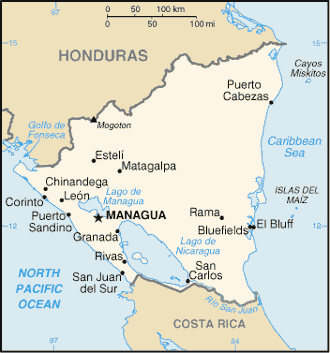Map:

Overview:
The Pacific Coast of Nicaragua was settled as a Spanish colony from Panama in the early 16th century. Independence from Spain was declared in 1821 and the country became an independent republic in 1838. Britain occupied the Caribbean Coast in the first half of the 19th century, but gradually ceded control of the region in subsequent decades. Violent opposition to governmental manipulation and corruption spread to all classes by 1978 and resulted in a short-lived civil war that brought the Marxist Sandinista guerrillas to power in 1979. Nicaraguan aid to leftist rebels in El Salvador caused the US to sponsor anti-Sandinista contra guerrillas through much of the 1980s. Free elections in 1990, 1996, and again in 2001 saw the Sandinistas defeated. The country has slowly rebuilt its economy during the 1990s, but was hard hit by Hurricane Mitch in 1998.
The People:
Population: 5,465,100 (July 2005 est.)
Age structure:
0-14 years: 37.2% (male 1,036,487/female 999,226)
15-64 years: 59.7% (male 1,623,065/female 1,638,017)
65 years and over: 3.1% (male 73,935/female 94,370) (2005 est.)
Religions:
Roman Catholic 72.9%, Evangelical 15.1%, Moravian 1.5%, Episcopal 0.1%, other 1.9%, none 8.5% (1995 census)
Government Type:
republic
Leader(s) to pray for:
chief of state: President Enrique BOLANOS Geyer (since 10 January 2002); Vice President Jose RIZO Castellon (since 10 January 2002); note - the president is both chief of state and head of government
head of government: President Enrique BOLANOS Geyer (since 10 January 2002); Vice President Jose RIZO Castellon (since 10 January 2002); note - the president is both chief of state and head of government
Source: The World Factbook
View All Countries